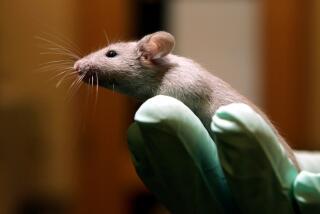‘Virgin birth’-created stem cells show hope
- Share via
In a scientific development suited to the season, Harvard University researchers have found a way to use “virgin birth” in mice to produce stem cells that are not rejected as foreign tissue.
The process is called parthenogenesis, in which unfertilized eggs are biochemically coaxed into embryonic development. Though the eggs don’t develop all the way to a live birth, they divide long enough for scientists to extract stem cells.
The technique may foreshadow a relatively straightforward way of making patient-specific stem cells that bypasses the technical challenges of producing cloned human embryos.
Other researchers have used parthenogenesis to create stem cells for mice and other animals, but those cells didn’t retain from the egg donor a key group of genes -- the major histocompatibility complex, or MHC -- that allows the immune system to distinguish native cells from foreign. Without the matched MHC genes, any tissue created from the stem cells risked being rejected when transplanted back into the animal.
The problem is caused by a scrambling of genes inside the egg before it divides. The Harvard researchers interfered with that natural recombination process, allowing the donor’s MHC genes to stay intact. Their findings were published Friday in the journal Science.
Because parthenogenesis requires an egg, it could only produce patient-specific stem cells for women in their reproductive years. But after further study, the technique might lead to a bank of cell lines with enough combinations of MHC genes to match 60% to 80% of the population, said Dr. George Daleyof Harvard Stem Cell Institute, senior author of the study.
“There’s a lot that remains to be done if you ever wanted to imagine clinical applications with human cells,” Daley said.







